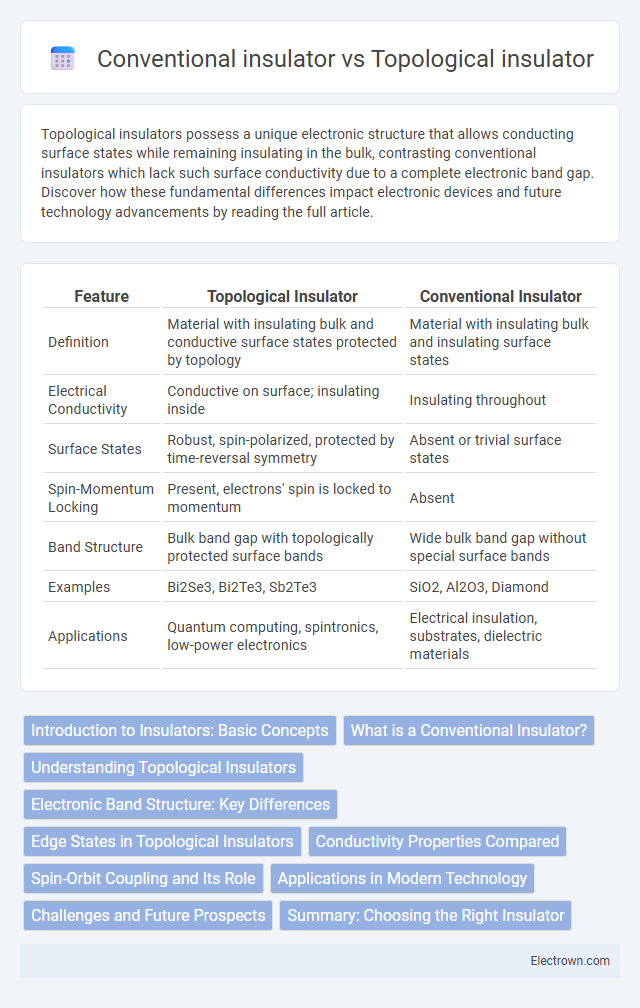Topological insulators possess a unique electronic structure that allows conducting surface states while remaining insulating in the bulk, contrasting conventional insulators which lack such surface conductivity due to a complete electronic band gap. Discover how these fundamental differences impact electronic devices and future technology advancements by reading the full article.
Table of Comparison
| Feature | Topological Insulator | Conventional Insulator |
|---|---|---|
| Definition | Material with insulating bulk and conductive surface states protected by topology | Material with insulating bulk and insulating surface states |
| Electrical Conductivity | Conductive on surface; insulating inside | Insulating throughout |
| Surface States | Robust, spin-polarized, protected by time-reversal symmetry | Absent or trivial surface states |
| Spin-Momentum Locking | Present, electrons' spin is locked to momentum | Absent |
| Band Structure | Bulk band gap with topologically protected surface bands | Wide bulk band gap without special surface bands |
| Examples | Bi2Se3, Bi2Te3, Sb2Te3 | SiO2, Al2O3, Diamond |
| Applications | Quantum computing, spintronics, low-power electronics | Electrical insulation, substrates, dielectric materials |
Introduction to Insulators: Basic Concepts
Topological insulators differ from conventional insulators by possessing insulating bulk states while hosting conductive surface states protected by time-reversal symmetry. Conventional insulators lack these protected surface states, resulting in complete electrical insulation throughout the material. Understanding the distinction in electronic band structures helps you grasp why topological insulators enable advanced applications in spintronics and quantum computing.
What is a Conventional Insulator?
A conventional insulator is a material that resists the flow of electric current due to a large energy gap between its valence and conduction bands, preventing electron mobility without external energy. Unlike topological insulators, which have conducting surface states protected by time-reversal symmetry, conventional insulators exhibit insulating behavior both in bulk and on the surface. Understanding the fundamental electronic band structure of conventional insulators can help you distinguish their properties from advanced quantum materials like topological insulators.
Understanding Topological Insulators
Topological insulators exhibit unique quantum states on their surfaces that conduct electricity while their bulk remains insulating, unlike conventional insulators that block electron flow entirely. These materials leverage spin-orbit coupling to create robust edge states protected by time-reversal symmetry, enabling dissipationless conduction critical for advanced quantum computing and spintronics applications. Understanding topological insulators can revolutionize Your approach to material science by harnessing their novel electronic properties for next-generation electronic devices.
Electronic Band Structure: Key Differences
Topological insulators exhibit an electronic band structure characterized by conductive surface states that arise from strong spin-orbit coupling, unlike conventional insulators which have a complete band gap preventing electron flow both in bulk and on the surface. The key difference lies in the presence of topologically protected edge states in topological insulators, allowing electrons to travel without backscattering, ensuring robust conductivity at the surface. Your understanding of these materials' band structures is essential for applications in quantum computing and spintronics.
Edge States in Topological Insulators
Topological insulators exhibit unique edge states that conduct electricity along their surfaces or boundaries, unlike conventional insulators that lack these conducting channels. These edge states are protected by time-reversal symmetry and remain robust against defects and impurities, ensuring stable electron transport. Understanding these properties allows you to explore innovative applications in quantum computing and spintronics.
Conductivity Properties Compared
Topological insulators exhibit unique surface conductivity due to conductive edge states protected by time-reversal symmetry, allowing electrons to flow with minimal scattering, while their bulk remains insulating. In contrast, conventional insulators lack these surface states, resulting in negligible electrical conductivity throughout both surface and bulk regions. This distinct disparity in electrical behavior underpins applications in spintronics and quantum computing for topological insulators.
Spin-Orbit Coupling and Its Role
Topological insulators exhibit strong spin-orbit coupling (SOC) that intertwines an electron's spin with its momentum, creating robust surface states immune to backscattering and localization. Unlike conventional insulators, where electrons are fully localized and SOC effects are negligible, topological insulators leverage SOC to generate conductive edge or surface channels while maintaining an insulating bulk. This unique interaction between spin and momentum driven by SOC underpins the quantum spin Hall effect and enables novel applications in spintronics and quantum computing.
Applications in Modern Technology
Topological insulators exhibit unique conductive surface states while maintaining insulating bulk properties, enabling advancements in spintronics and quantum computing by allowing lossless spin current transport. Unlike conventional insulators, which prevent electron flow entirely, topological insulators facilitate energy-efficient electronic devices through robust edge state conduction resistant to defects and impurities. Their application in next-generation sensors, low-power transistors, and fault-tolerant quantum bits distinguishes them as critical materials in modern technology innovation.
Challenges and Future Prospects
Topological insulators exhibit unique surface states resistant to scattering, posing challenges in integrating them with conventional semiconductor technologies due to material defects and interface stability. Overcoming these obstacles requires advanced fabrication techniques and precise control over quantum properties to harness their potential in spintronics and quantum computing. Your exploration of these materials could drive innovations in low-power electronic devices and robust information processing systems.
Summary: Choosing the Right Insulator
Topological insulators exhibit unique surface conductivity while maintaining insulating behavior in their bulk, unlike conventional insulators that prevent electron flow throughout. Their robust edge states resist impurities and defects, making them ideal for advanced electronic and quantum computing applications. Understanding your specific conductivity and durability needs will help determine whether a topological insulator or a conventional insulator best suits your technology goals.
topological insulator vs conventional insulator Infographic

 electrown.com
electrown.com